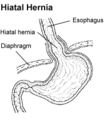What Is an Esophageal Hernia?
The Anatomy of an Esophageal Hiatal Hernia
For individuals who have this type of hernia a part of the stomach passes through the esophageal hiatus, which is the opening in the diaphragm through which the esophagus connects from the chest to the abdomen. Many people have this condition without even knowing it. In other cases a person may experience GERD symptoms and the upper part of the stomach can become trapped. With a serious hernia surgery may be necessary.
What causes an esophageal hernia, also simply known as a hiatal hernia? When the hiatus weakens or enlarges the stomach can slide through. The cause is often unknown. Some people are born with a large esophageal hiatus, other factors can stress the abdomen, weakening and enlarging. Weight gain, excessive coughing, pregnancy, and difficult bowel movements can put pressure on the abdomen and possibly contribute to a hiatal hernia. There is an increased rate of hernias in the over 50 population.
There are two different types of esophageal hernia. One is less of a health concern, and the other may require surgical treatment if it is very large. The first type is a sliding hiatal hernia. Some of the stomach slides through the opening when food is swallowed. Symptoms are usually non existent and treatment is not necessary. With a para-esophageal hernia the stomach remains trapped in the chest cavity. This can make food passage difficult. It can also cause the formation of ulcers. A large para-esophageal hernia is treated with a surgical procedure, but this more extreme form of this condition is very uncommon.
Symptoms and Diagnosis
What symptoms may be present for someone who has a hernia? WIth a sliding hiatal hernia there are usually no physical signs, although a larger hernia may cause the symptoms of gastroesophageal reflux disease (GERD) — heartburn, an upwelling of stomach acids, and nausea. Other possible symptoms include chest pressure, trouble swallowing, hiccups, coughing, and upper abdominal pain.
If you are experiencing these symptoms it is important to make an appointment with your doctor for a proper diagnosis. A series of tests will be done to rule out more serious health problems such as heart disease and to identify what is causing the symptoms. Blood tests, x-rays, and an electrocardiogram may all be done for a doctor to diagnose a hiatal hernia and to identify the severity of the problem.
Treatment
A smaller esophageal hernia may be addressed in the same way that GERD symptoms are treated. Changes to diet, sleeping on an incline, avoiding heavy lifting, and avoiding food before bedtime are all lifestyle changes that may be recommended. Over-the-counter and prescription antacids may also be suggested to control symptoms. Surgery is only needed in rare cases. In a surgical operation the stomach would be returned to the abdominal cavity and the esophageal hiatus would be tightened.
An esophageal hiatal hernia is often not a serious health problem and symptoms can be managed in the same way that gastroesophageal reflux disease is managed. It is very important however to see a doctor if you are experiencing symptoms to be diagnosed and to discuss treatment options.
References
EMedicine Health https://www.emedicinehealth.com/hiatal\_hernia/article\_em.htm#Hiatal%20Hernia%20Overview
MedicineNet https://www.medicinenet.com/hiatal\_hernia/article.htm
EHealthMD https://www.ehealthmd.com/library/heartburn/hb\_treatment.html
WebMD https://www.webmd.com/heartburn-gerd/hiatal-hernia
photo by National Institutes of Health
